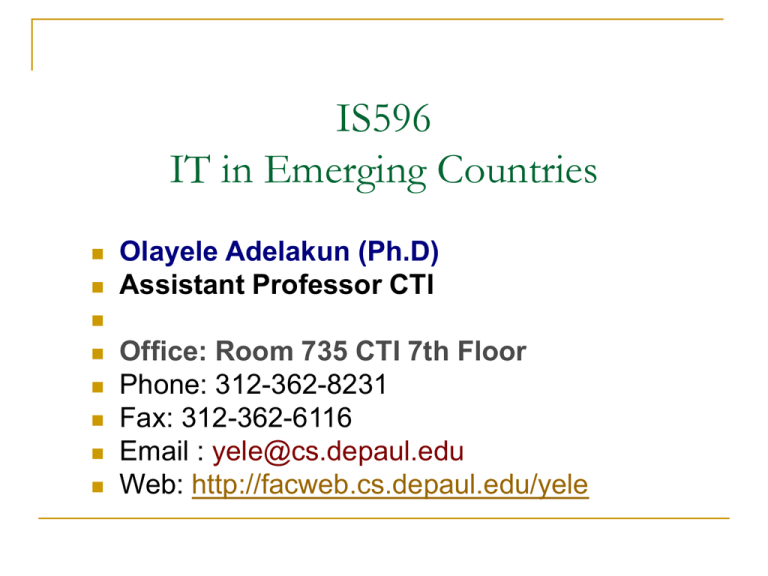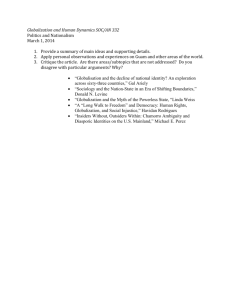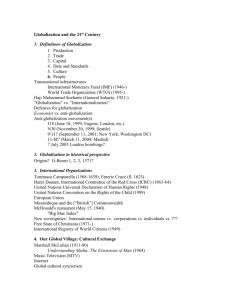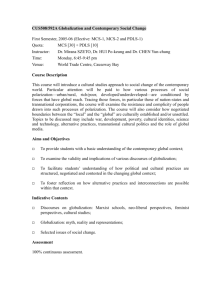global it - DePaul University
advertisement

IS596 IT in Emerging Countries Olayele Adelakun (Ph.D) Assistant Professor CTI Office: Room 735 CTI 7th Floor Phone: 312-362-8231 Fax: 312-362-6116 Email : yele@cs.depaul.edu Web: http://facweb.cs.depaul.edu/yele Agenda Expectation? Course Overview Areas of Interest Lecture Notes Expectations? 1. Reasons to study IT in Emerging Country 2. What would you like to get out of this course. Agenda Expectations? Course Overview Areas of Interest Lecture Notes Course Overview Objective Topics Course Materials Assignments Objectives A better understanding of the IT challenges facing organizations in emerging countries A better understanding of issues involved in building a success global software team. Students will have a practical exposure to the reality of information technology (IT) in an emerging/developing country (Brazil). A visit to Rio Topics Information Technology Impact on Transnational Firms Global Software Teams Assessment of Global Software Teams Problems of Global Software Teams Solutions to the Global Software Teams Problems Crossing Borders Telecommunications Infrastructure Development Methodology Architecture and Task Allocation Building the Dispersed Team through Trust, Communication, and Personal Bridges Specialized Management Techniques Offshore IT Outsourcing Course Materials Case studies HBS Cases 1. 2. Submarino.com: The Challenges of B2C Commerce in Latin America. Case 801-350 PSA: The world’s Port of Call. Case 802-003 Other supporting documents 1. Readiness for the Networked World: A guide for Developing Countries by Center for International Development at Harvard University. Grading Individual Assignments 10% Class Attendance and Participation 30% Group Assignment 20% Paper 25% Group Presentation 15% Total 100% Group Assignment About 3-5 Students per group Analyze one category of the readiness guide. No single category may be selected by two groups Deliverables include Group contribution to the class web site Presentation of readiness for ICT (only one category per group) Question Agenda Expectations? Course Overview Areas of Interest Lecture Notes Reference Discipline Political Science Economics Law Management International business Human computer Interface Cross cultural studies Law Sociology Psychology Telecommunications Computer Science Globalization A definition: As increased permeability of traditional boundaries such as nations, time and space (Parker, 1998) GLOBAL IT ISSUES Issues of Interest To what extent does the growing power of information technology enable globalization? To what extent does increased globalization create demand and markets for ever more refined information technology? Do the new technologies enable firms to consider new markets and new activities? Do the desires of firms for international activities create demand for new technologies? Are uses for information technology in a global setting merely the logical extension of domestic information technologies? Does operating internationally create new areas of decision making such as the structure for direct foreign investment (Iyer, 1988)? IT in Emerging Countries Area of Interest National or Country level Multinational firms (IT vendors and non-IT vendors) Local vs. global issues Groups and teams Individual IT Issues in Emerging Countries Global IS Issues At the National level Social and cultural issues at the country level Economics Technology sophistication at the country level IT policy and legal issues IT Issues in Emerging Countries Global IS Issues At the organizational level Issues involving matching global IS strategy with global business strategy Issues on the technical platform for Global IS applications Issues involved in International data sharing Issues of global IS projects IT Issues in Emerging Countries Global IS Issues At the group level level Global software teams co-ordination Global project management Distance and time differences Cultural issues IT Issues in Emerging Countries Complexity in Understanding Global IS Global IS is an extremely broad topic. There are numerous potential stakeholders. Global IS can be addressed from the perspectives of (1) national governments, (2) economic regions (e.g. EU), (3) multinational and domestic firms, (4) firms building vs. using IS technology, (5) IS (or other) departments within firms, (6) labor markets within countries, and (7) consumers. (8) different business processes across boarders IT Issues in Emerging Countries Based on detailed interviews with IS executives charged with managing international IS, Ives and Jarvenpaa (1991) outline four aspects of global IS: 1. Matching global IS strategy to global business strategy; 2. Issues involving the technical platform for global IS applications 3. Issues involved in international sharing of data; and 4. Issues of IS projects spanning cultures. IT Issues in Emerging Countries Other ways to study IT in Emerging Countries The impact of information on people of different cultures; The differences in information sought and used by people of different cultures (and the strategies and approaches to decision making and other task performance by people of different cultures); and The mechanisms for developing information systems to be developed and/or used by people of different cultures. 1. 2. 3. 4. For example to what extent do design methodologies used in France, Germany, Japan, or India account for specific cultural values, Can lessons learned in these countries enrich design methodologies used in Canada or the U.S.? Diffusion of IS in developing countries Agenda Expectations? Course Overview Areas of Interest Lecture Notes Globalization and Information Systems Forces Driving IT in Emerging Countries Demand for new global consumer New global business customer Global outsourcing Global product R&D Internal development Individual development Globalization and Information Systems Transnational Corporations The traditional organizational form is changing to one that is both integrated and more similar to a network organizational structure. This new form is labeled transnational corporation. Globally efficient Strong locally Big and small at the same time IT is central to the success of its operations IT is part of the corporate strategy Globalization and Information Systems Global demand The global customer Global sourcing and integration of the supply chain Global design (e.g. ford CAD) Harmonization and standardization of report requirements Products are being assembled from multiple sources and information systems are used to coordinate the logistics Global product R&D and shorter product cycle Demand for global services and products (hotel, airline, etc.) Account Global strategy Economy of Scale Globalization and Information Systems Implication of Globalization on IS department IS department need to be global as well Integrated Network in which global systems maintenance and development efforts are increasingly shared across boarders This means that responsibilities are shared globally. Globalization and Information Systems Implication of Globalization for the IS function The Integrated Network IS Organization Development of global applications that support global processes rather than local or regional processes. A shift away from geographical or national boundaries Decentralized IS unit operates independently Globalization and Information Systems Corporate Structure Systems IS Development Centralized Centralized databases and processes driven by headquarters Headquarters centralized development and decision making Decentralized Standalone, largely independent Independent at each subsidiary Coordinated Federation Linked databases with Some joint development; some application sharing formalization and standards established Integrated Network (Transnational) Integrated architecture; shared databases and shared global processes Centers for global application Globalization and Information Systems Characteristics of Integrated Networks Common global architecture Powerful telecommunication backbone Uniform global systems with flexible modules tailored to address systems worldwide A culture of shared management A culture of shared application building A culture of shared innovation Globalization and Information Systems Characteristics of Integrated Networks Global IT strategy driven by senior executives Financial, operations support Standardization Architecture, telecom, application, hardware, development process, quality standards etc. To ease communication between units and partners Ease of data transfer Ease of application reuse Globalization and Information Systems Center for Global Applications Is a development center that unifies all development work for one or more global application systems The center are responsible multiple releases of the global applications The center “own” the global system End-to-end responsibility from requirement and enhancement requests through pilot testing and global roll-out. Globalization and Information Systems Center for Global Applications CGA Problems Conflict with local or country manager Business case must be convincing Flexibility Budgets source Creation of a liaison role with the local operation 360 view. Globalization and Information Systems Agenda Expectations? Course Overview Areas of Interest Lecture Notes



